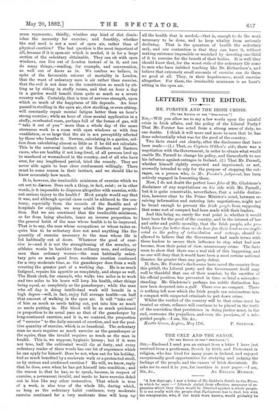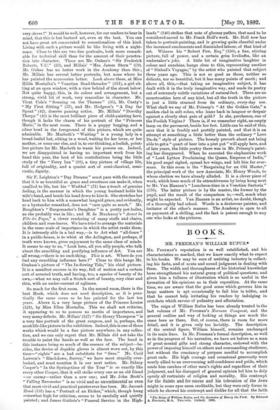THE CELT AND THE SAXON. [To THE EDITOR OF THE
" SPECTATOR."] SIR,—Enclosed I send you an extract from a letter I have just received from a gentleman, Scotch by birth, and Protestant in religion, who has lived for many years in Ireland, and enjoyed exceptionally good opportunities for studying and judging the feelings of the people, and the causes of Irish discontent. He asks me to send it to you, for insertion in your paper.—I am, "A few days ago, I saw a letter of Mr. Goldwin Smith to the Times, in which he says :---` Liberals shrink from effective measures of re- pression which they think would be directed against a whole people. It is not really with the people that Parliament has to deal, but with the conspirators, who, if the truth were known, would probably be very clever !" It would be well, however, for our readers to bear in mind, that this is but bastard art, even at the best. You can not have great art consecrated to sensationalism of this kind. Living with such a picture would be like living with a night- mare. Close to this are two fine portraits, both more remark- able for technical skill than for the amount of their penetra- tion into character. These are Mr. Oaless's " Sir Frederick Roberts, V.C." (23), and Millais' "Mrs. James Stern" (29). Mr. Ouless has no better work in the Academy than this ; Mr. Millais has several better portraits, but none where he has painted the accessories better. Look above these, at Miss Hilda Montalba's " Venetian Bead-threader " (311), a girl sit- ting at an open window, with a view behind of the street below'. Not quite happy, this, in its colour and arrangement, but a strong, vivid bit of work, very masculine in character. Mr. Vicat Cole's " Sonning on the Thames" (35), Mr. Canty's " My First Sitting " (37), and Mr. Hodgson's "A Day far Spent" (42), deserve passing notice. Mr. Millais' "Dorothy Thorpe " (43) is the most brilliant piece of child-painting here, though it lacks the charm of his portrait of the "Princess Marie," in the next room. There is a puppy begging, and a silver bowl in the foreground of this picture, which are quite admirable. Mr. Macbeth's " Waiting " is a young, lady in a broad-leafed hat, sitting in a wood, waiting for her lover, or her mother, or some one else, and is, to our thinking, a foolish, point- less picture for Mr. Macbeth to waste his powers on. Indeed, we are disappointed in having no important work from his hand this year, the best of his contributions being the little study of the " Ferry Inn " (93), a tiny picture of village life, fall of originality, and a quaint sort of semi-classical, semi- rustic, dignity.
Sir F. Leighton's " Day Dreams " must pass with the remark that it is as beautiful as grace and sweetness can make it, when =allied to life, but his " Wedded" (71) has a touch of genuine feeling, in the manner in which the young husband holds his wife's hand, and bends his head down to kiss it. She stretches her head back to him with a somewhat languid grace, and evidently, as a bystander remarked, does not " care quite so much." Mr. Boughton's " Burgomaster's Daughter " is a pretty pot-boiler, as she probably was in life; and M. de Munkacsy's "Avant la Paz du Papa," a clever rendering of many stuffs and chairs, children and rose-leaves. We have tried to arrange the materials in the same scale of importance in which the artist ranks them. It is intensely able in a bad way,—is to Art what "all-fours " in a public-house, is to whist at the Arlington, and perhaps, if truth were known, gives enjoyment to the same class of minds. It seems to say to us, " Look here, all you silly people, who talk about the ennobling and purifying influence of Art. You are all wrong,—there is no such thing. This is art. Where do you find any ennobling influence here ?" Close to this hangs Mr. Graham's picture of " The In-flowing Tide," his chief picture. It is a manifest success in its way, full of motion and a certain sort of arrested truth, and having, too, a species of beauty of its own,—what we may call a Scotch sort of beauty, very clear and thin, with an under-current of ugliness.
So much for the first room. In the second room, there is the best Hook, which does not need description, as it is prao- tically the same scene as he has painted for the last ten years. Above it, a very large picture of the Princess Louise (124), by Miss Ellen Montalba. This we shall not criticise, it appearing to us to possess no merits of importance, and very many defects. Mr. Millais' (127) " Sir Henry Thompson " is a very fine portrait of the great surgeon, and is, perhaps, the most life-like picture in the exhibition. Indeed, this is one of those works which would be a fine picture anywhere, in any collec- tion, and we can only regret that Mr. Millais did not take the trouble to paint the hands as well as the face. The hand in this instance being so much of the essence of the subject—be- sides, the device of dogskin gloves is almost worn out, by this time—" eights " are a bad substitute for " fives." Mr. Cecil Lawson's " Blackdown, Surrey," we have most stupidly over- looked, and must mention it in our next notice. Mr. Sidney Cooper's "In the Spring-time of the Year" is so exactly like every other Cooper, that it will strike every one as an old friend —or enemy—rather than a new one; and Mr. John Brett's " Falling Barometer " is as vivid and as unsentimental as even that most vivid and practical painter ever has been. Mr. Jacomb Hood (131) has a "Portrait of an Etcher," which, though hung somewhat high for criticism, seems to be carefully and quietly painted; and James Guthrie's "Funeral Service in the High- lands " (146) strikes that note of gloomy pathos, that used to be considered sacred to Mr. Frank Holl's work. Mr. Holl now has taken to portrait-painting, and is growing quite cheerful under the increased emoluments and diminished labour, of that kind of art. Witness his " Robert Few, Esq." (150), a fine, stirring picture, full of power, and a certain grim livelindss, like an undertaker's joke. A little bit of imaginative laughter in colour and sunshine, hangs close to this, representing another of " Sinbad's Voyages," by the artist who painted that subject three years ago. This is not so good as those, neither so delicate, nor so beautiful, but it has many points of merit; and above all, this,—that taking an imaginative subject, it has dealt with it in the truly imaginative way, and made its poetry out of extremely subtle variations of natural fact. There are no monstrosities here of any kind, but all the truth in the picture is just a little strained from its ordinary, every-day use. What shall we say of Mr. Prinsep's "At the Golden Gate," a maiden clad in soft robes, who leans back in languor or despair against a closely shut gate of gold P Is she, perchance, one of the Foolish Virgins P There is, if we remember right, an empty lamp on the pavement, beside her feet. Little can be said of this, save that it is freshly and prettily painted, and that it is an attempt at something a little better than the ordinary " Love Da-da " style of picture. The homely proverb about not being able to get a " quart of beer into a pint pot " will apply here, and of late years, the little poetry there was in Mr. Prinsep's paint- ing has disappeared. When he executed the elephantine work of " Lord Lytton Proclaiming the Queen, Empress of India," his good angel sighed, spread her wings, and left him for ever- more. In this room is the " Bargaining for an Old Master," the principal work of the new Associate, Mr. Henry Woods, to whose election we have already alluded. It is a clever piece of work, which loses mach of its attractiveness by being hung next to Mr. Van Haanen's " Luncheon-time in a Venetian Sartoria " (176). The latter picture is by the master, the former by the pupil, and the result of the comparison is,—well, much what might be expected. Van Haanen is an artist, no doubt, though of a thoroughly bad school. Woods is a dexterous painter, and imitator of the other's manner. The Academy is open to all on payment of a shilling, and the fact is patent enough to any one who looks at the pictures.

































 Previous page
Previous page